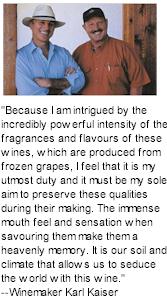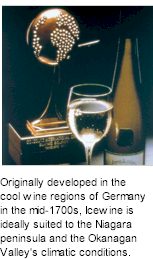


Inniskillin's vineyard is called 'Brae Burn' a name of Gaelic origin which translates literally as 'hill stream' referring to the Niagara Escarpment and River. The historic Brae Burn Barn, constructed in the mid-1920s, houses the winery boutique. The main floor consists of the retail wine boutique and tour centre, while the upper level loft, maintained in its original open-beamed structure, features a training centre and demonstration kitchen for guest chefs, and a gallery.

The barn and several others in the area were constructed in a similar style and are thought to be designed or influenced by the famous architect Frank Lloyd Wright, who designed the Larkin Building in Buffalo, New York. Architects have admired the functional simplicity, integrity and craftsmanship of the barn.
In 1975, Inniskillin Wines was granted the first winery licence in Ontario Canada, since 1929. Established in Niagara-on-the-Lake and taking its name from the early history of the area, Inniskillin was founded upon and dedicated to the principle of producing and bottling outstanding wines from select wine grapes grown in the Niagara Peninsula.
Karl and Donald eventually shared a bottle of Karl's home-made wine. After a lot of dreaming and talking, they decided to apply for a wine licence. The late General George Kitching, Chairman, Liquor Control Board of Ontario, shared the two men's vision of a premium estate winery producing varietal wines from grapes grown in the Niagara Peninsula, and with his assistance, Inniskillin was born.

The first Inniskillin winery was housed in an old packing shed at the family nursery, and in 1978 relocated to the present site at The Brae Burn Estate.
In building the new winery at Brae Burn the plan was to combine Old and New World wine regions to create an estate winery that would harmonize architecturally with the natural and historic surroundings and create a Canadian character. The winery was designed by Raphaele Belvedere, a local architect, to allow technological needs to blend with the historic environment of the site. It is adjacent to the existing Inniskillin vineyards, planted in 1974 and now known as the Seeger vineyard.
Inniskillin endeavours to ensure that their wines are a lasting pleasure to people who enjoy good food and wine everywhere. After a deep sleep for almost 50 years, the Canadian wine industry has experienced a dramatic rebirth over the last two decades. The Niagara Peninsula and Okanagan Valley wines express the styles and flavours of the major grape varietals grown in these regions.
In premium reds, Pinot Noir has found a high-quality niche in Niagara, while Merlot is the focus in the Okanagan. From Chardonnays and Rieslings to Pinot Grigio and Pinot Blanc, Canadian whites have also assumed their rightful place at the global dinner table. When Inniskillin first won the coveted Grand Prix d'Honneur at Vinexpo in Bordeaux, France for its 1989 Icewine, the seal of international approval for the bounty of Canadian viticulture was guaranteed.

























